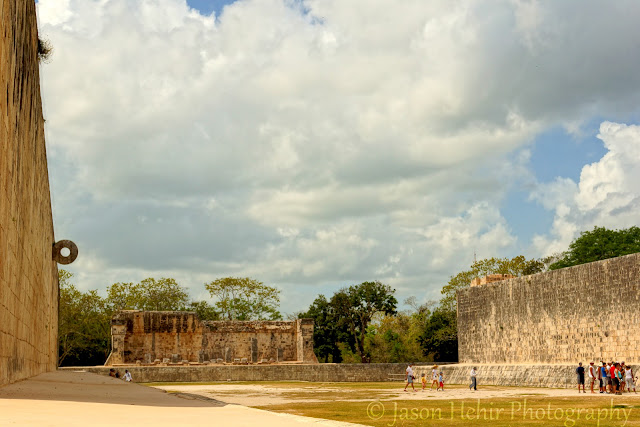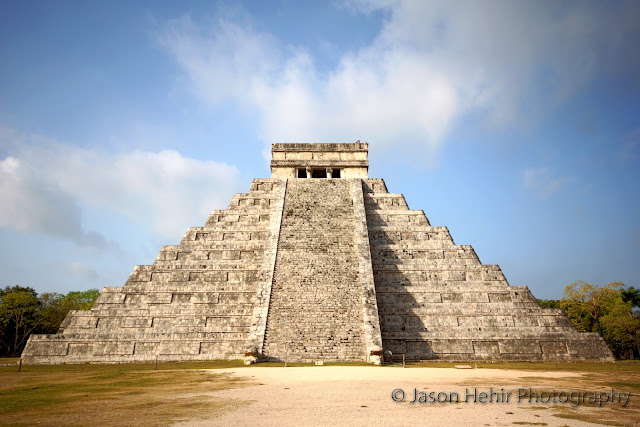This is it. This is the Big One. This is the one I had been waiting for since I was a kid, the place in all of the promised land of Mexico that I was most keen to see. I had hiked to Macchu Picchu, hunted down the Northern Lights, seen the Great Pyramids at Giza and now I was about to see Chichen Itza. I was excited, but where to begin.....
The town currently nearest to Chichen Itza is a small, unremarkable place by the name of Piste that lies halfway between Merida and Cancun. We arrived mid afternoon having hot footed it up from Tulum on a local bus. We planned to spend at least a couple of days in the area taking in the pyramids, some local caves and the cenotes I wrote about previously next to the nearby town of Valladolid. We had deliberately picked a more expensive hotel for this stay but the benefit was it was actually within walking distance of the complex so that, with an early start, we could beat the crowds that would be bussed in from locations further afield, but that was for tomorrow. That evening we decided to get tickets to the sound and light show that is put on each night. This basically involves using the pyramid as a huge projector screen and explaining some of the history of the monument using a lot of bright lights and a big ass sound system; I believe there is something similar done with the pyramids at Giza.
I'll be honest, the show was crap and I do not recommend it. It reeked of the 1980s and badly needed updating. The story was only in Spanish so we could get the general gist if we concentrated but anyone without a decent grasp of Spanish would probably get pretty bored pretty quickly, as we eventually did. The colourful lights could only hold your attention so long and so the whole experience was a little underwhelming. What I was pleased about, however, was that it allowed me to plot a mental map of the site so that, in the morning, I would be able to march us straight to the main points of interest and hopefully get even more of a head start on most of the other tourists.
And so it proved. The next day we were queuing up before the site was opened so that we could be amongst the first people over the threshold. Using my recently reconnoitered information we made straight for the main draw overtaking the less well informed tourists as we went. Once we arrived the only people there were a few gardeners doing some early morning weeding before the heat became unbearable; we had even beat the hawkers to it, they were still busy setting up their wears, only concerned with being ready before the coaches started arriving. The Great Pyramid; El Castillo; Kukulcan; call it what you will, this is a very impressive structure and the chances are that you've seen a picture of it before. It is the archetypal image of Mayan and Mexican culture and the tourist board, understandably, make a big deal of it and attract 1.2m people per year in the process. That being said it is only the second most visited archaeological site in Mexico after Teotihuacan, which I'll deal with in a future post. Chichen Itza, though, is unarguably the more picturesque of the two.
 |
| Not a good picture, hand held in the dark, but it gives an impression of the sound and light show - not all that. |
The story behind Chichen Itza begins in the 5th century when a settlement was established next to two large cenotes that are found in the area guaranteeing a reliable water supply. It was the Itza people that built the village into a large and prosperous conurbation, indeed the name Chichen Itza means 'the mouth of the well of the Itza.' From about the year 750 there began a golden age for the city that was to last half a millennium, but it was not completely without incident. For the first 200 years or so the Itza people, an ethnic subset of the Maya, prospered and grew their sphere of control building temples and palaces as they went; this was all done in their own cultural and architectural style so that the first phase of building in the area is very distinct. Equally distinct, though, is the Toltec style which takes over and comes to dominate the area come the 10th century.
 |
| One of the two cenotes that fed Chichen Itza. For a sense of scale try to spot the guy in the red t-shirt on the right. |
 |
| The pelota court with one of the two hoops through which the ball would be aimed |
 |
| This gentleman was carrying his goods to the make-shift market passed the Temple of 1000 Columns |
This pyramid is full of meaning and symbolism; as well as being an obvious symbol of power and advanced technology, the single most impressive aspect of this structure is what it reveals of the Mayan's mathematical and astronomical abilities. It is effectively a giant calendar, there are 91 steps from the base to the summit on each side with one last one at the top on which sits the temple, this makes 365 in total; I don't need to tell you the significance of that number. Also, and this draws tens of thousands of visitors every year, on the spring and autumn equinoxes the pyramid is aligned such that one of it's stepped edges casts a shadow onto the side of one of the staircases that gives a shade-like body to the serpent that runs down the pyramid. This was probably a deliberate design feature but there are some archaeologists that claim it is a coincidence.
I can't really talk about the Mayans and their calendar without mentioning the now infamous end of the world predictions that have become so popular in recent years. Let me begin by saying that they are, of course, bullshit. What is galling, though, is that the Mayans didn't even predict the end of the world, they believed that there would be a pretty much endless series of cycles that would last for millions of years. During the winter solstice this year, December 21st, one of their many cycles will come to an end. On December 22nd another one will begin. Apparently there are people that will pre-emptively kill themselves in time for this event in much the same way people said they would for the Rapture that failed to materialise last year and I certainly wouldn't want to stop them; it'd be nice to have a little dose of good old Darwinian natural selection brought to the table.
Returning to what we do know, the Maya had 13 weeks each of 20 days (their numbering system was base 20) in their ceremonial year giving 260 days. They thought that the number 13 was unlucky so the 13th day of the 13th week was a particularly bad day to be walking under ladders in Chichen Itza. Obviously this ceremonial calendar didn't fit in with their observations of reality and so they also came up with an astronomical calendar that had 18 periods of 20 days totalling 360 days. This gave them 5 left over which they considered literally unstable and dangerous as they belonged to neither one year nor the other. To mesh these two separate calendars together they came up with a system of two cogs of unequal size that cycled around each other known as the Calendar Round; and how long did it take for the two to catch each other up and get back to where they started? Surprise, surprise, 52 years. There's no escaping these numbers. The Mayans were so accurate in their time keeping that it can be worked out that, according to their own legends, the earth was created on August 11th, 3314BCE; this is a fairly similar sort of date for pre-history in many other cultures.
Chichen Itza, then, is a place where two cultures collided to produce one of the most interesting sites in all of Mesoamerica. It existed for nearly one thousand years and was the major economic and military power in the region for more than half of that; but then it all came to a sudden end, and no one knows why. It wasn't that unusual for whole cities like this to suddenly become uninhabited but the Mayans, such fastidious record keepers, usually made a note of why, whether it be because they were conquered by another tribe; a drought; some sort of disease pandemic; or sometimes they would do it deliberately as one of their calendar cycles came to an end and they felt that it was time to start again. Many theories compete to explain why, sometime in the 14th century, there ceases to be evidence of any new buildings or development of any kind. Some say they were conquered, others that the civilisation just ran out of steam in a slow decline over a century or so. We may never know, but when the Spanish arrived in 1526 there was still a population there although it was much reduced. Over the next decade the conquistadors tried and failed to conquer the region, but by the 1580s the inevitable happened and the area became nothing more than a cattle ranch.
Today, the area has been officially declared as one of the new Seven Wonders of the World along with the Great Wall of China; Petra in Jordan; Christ the Redeemer in Rio; the Colosseum in Rome; the Taj Mahal in Agra (where my great grandmother was born) and, my favourite, Machu Picchu in eastern Peru. I am very much a list ticking type of person, I have been to three of these places already and am hoping to get a fourth by the end of this year; maybe I could try and get them all by the end of the decade? In any case, this recognition as one of the worlds treasures has guaranteed the future of Chichen Itza for years to come for locals and visitors alike and I, for one, am very happy about that.




No comments:
Post a Comment